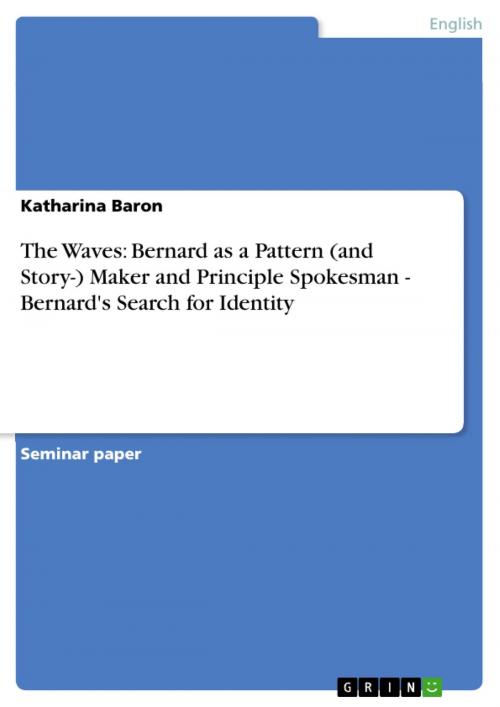The Waves: Bernard as a Pattern (and Story-) Maker and Principle Spokesman - Bernard's Search for Identity
Bernard's Search for Identity
Fiction & Literature, Literary Theory & Criticism, British| Author: | Katharina Baron | ISBN: | 9783638562539 |
| Publisher: | GRIN Publishing | Publication: | October 29, 2006 |
| Imprint: | GRIN Publishing | Language: | English |
| Author: | Katharina Baron |
| ISBN: | 9783638562539 |
| Publisher: | GRIN Publishing |
| Publication: | October 29, 2006 |
| Imprint: | GRIN Publishing |
| Language: | English |
Seminar paper from the year 2006 in the subject English Language and Literature Studies - Literature, grade: 2.3, http://www.uni-jena.de/ (Institut für Anglistik/Amerikanistik), 7 entries in the bibliography, language: English, abstract: The experimental novel The Waves by Virginia Woolf was published in 1931. By describing the search for identity Woolf has the aim to show that identity consists of a variety of selves. For that reason the question 'Who am I' is central to all characters in the novel. Woolf introduces a circle of friends that consists of seven people and describes the lives of the characters from childhood until they are old. Six characters, three men and three women, get voices and express themselves. The seventh, a man called Percival, does not speak, he is introduced by the other characters Susann, Jinny, Rhoda, Neville, Louis, and Bernard. The friends present themselves through their monologues, but they do not talk to each other, they just tell their own thoughts. The reader moves from consciousness to consciousness and only by the inquit formula 'said [name of character]', one can recognize who is speaking. Stylistic similarities of the monologues hint that Virginia Woolf actually intended to present the consciousness of a single person and not of six different individuals. Therefore this stylistic feature serves to illustrate the concept of a multiple self. The focus of this essay will be on Bernard because he is '[...] the primary voice in the novel'. His search for identity will be shown and it will be illustrated how Virginia Woolf's uses this character to illustrate the concept of an identity that consists of various elements. At the beginning Bernard's key position in the novel will be considered. Then some aspects of Bernard's search for identity will be discussed and at the end Bernard's function for the unity of the novel and of identity will be shown.
Seminar paper from the year 2006 in the subject English Language and Literature Studies - Literature, grade: 2.3, http://www.uni-jena.de/ (Institut für Anglistik/Amerikanistik), 7 entries in the bibliography, language: English, abstract: The experimental novel The Waves by Virginia Woolf was published in 1931. By describing the search for identity Woolf has the aim to show that identity consists of a variety of selves. For that reason the question 'Who am I' is central to all characters in the novel. Woolf introduces a circle of friends that consists of seven people and describes the lives of the characters from childhood until they are old. Six characters, three men and three women, get voices and express themselves. The seventh, a man called Percival, does not speak, he is introduced by the other characters Susann, Jinny, Rhoda, Neville, Louis, and Bernard. The friends present themselves through their monologues, but they do not talk to each other, they just tell their own thoughts. The reader moves from consciousness to consciousness and only by the inquit formula 'said [name of character]', one can recognize who is speaking. Stylistic similarities of the monologues hint that Virginia Woolf actually intended to present the consciousness of a single person and not of six different individuals. Therefore this stylistic feature serves to illustrate the concept of a multiple self. The focus of this essay will be on Bernard because he is '[...] the primary voice in the novel'. His search for identity will be shown and it will be illustrated how Virginia Woolf's uses this character to illustrate the concept of an identity that consists of various elements. At the beginning Bernard's key position in the novel will be considered. Then some aspects of Bernard's search for identity will be discussed and at the end Bernard's function for the unity of the novel and of identity will be shown.















